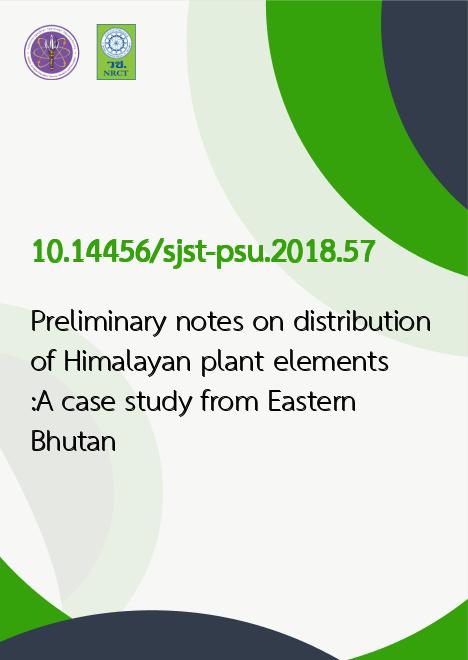
|
Preliminary notes on distribution of Himalayan plant elements:A case study from Eastern Bhutan |
|---|---|
| รหัสดีโอไอ | |
| Creator | 1. Tshering Tobgye 2. Kitichate Sridith |
| Title | Preliminary notes on distribution of Himalayan plant elements:A case study from Eastern Bhutan |
| Publisher | Research and Development Office, Prince of Songkla University |
| Publication Year | 2561 |
| Journal Title | Songklanakarin Journal of Science and Technology |
| Journal Vol. | 40 |
| Journal No. | 2 |
| Page no. | 370 |
| Keyword | lower montane forest, Eastern Himalaya, Bhutan, far-east Asia, plant distribution |
| URL Website | http://rdo.psu.ac.th/sjstweb/index.php |
| ISSN | 0125-3395 |
| Abstract | Vascular plant species composition surveys in the lower montane vegetation of "Korila" forest, Mongar, EasternBhutan, identified 124 species, which constitutes an important component of the vegetation. Findings revealed that majority ofthe species were herbs including pteridophytes (ferns and lycophytes) (48.3%), followed by trees (23.4%), shrubs (20.9%), smalltrees (4.8%), (4.8%), and climbers/creepers (2.4%). Plant species composition and the vegetation analysis showed that thevegetation falls in lower montane broad-leaf forest type containing Castanopsis spp. and Quercus spp. (Fagaceae). A vegetationcomparison study of the area with lower montane forest in South-East Asia through literature revealed that the true Himalayanelement distribution range ended in the North of Thailand where the Himalayan range ends. But surprisingly, the study found thatsome Himalayan elements could extend their southernmost distribution until North of the Peninsular Malaysia. Thus, it can beconcluded that the Himalayan range had formed an important corridor. |
